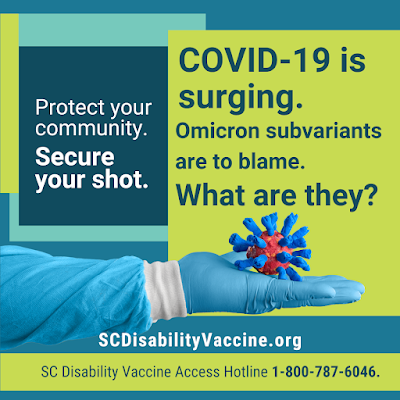Learn more about why COVID-19
is surging in SC today
What is a COVID-19 variant?
A COVID-19 variant is a version of the COVID-19 virus that’s a little different from the version before it. COVID-19 variants can spread faster and more easily. Variants can also make you sicker.
Some of the variants that you might hear a lot about are Omicron variant, and the BA5 subvariant. These variants spread easily and can make you very sick.
Variants of viruses are common. People with disabilities are at a higher risk of getting COVID-19. We are also at higher risk of getting COVID-19 variants.
What is a subvariant of the COVID-19 variant, Omicron?
An Omicron subvariant is a version of Omicron that has had a change in its spike protein. These changes can make this version act differently than other versions of Omicron. For example, some Omicron subvariants spread easier than others. (Sources: 5, 7)
BA. 4 and BA.5 are subvariants of the Omicron strain of the COVID-19 virus. BA.5 is the subvariant causing most COVID cases in the U.S., today (Sources 1, 11). The Omicron variant was first noticed in South Africa in November 2021. In December 2021the Omicron variant was found in the United States. In early 2022, the BA.2 strain was found. It became the most common and contagious subvariant of Omicron. Today there are new strains, BA.4 and BA.5, that spread even faster (Source 2).
Why are BA.4 and BA.5 more contagious?
Spike protein how COVID-19 virus attaches to cells and infects you (Source 4, Source 5). The differences in the BA.5’s Spike protein cause it to spread more easily (Source 3).
Studies suggest that BA.5 has some resistance to the mRNA vaccines (Source 3). In the U.S., the two mRNA vaccines are Moderna and Pfizer. Scientists are working to make new COVID-19 vaccines that are stronger against the Omicron BA.4 and BA.5 variants.
How can I protect myself from getting sick with the Omicron BA.4 and BA.5 variants?
BA.4 and BA.5are better at avoiding our current mRNA vaccines than other variants. But it is still important to get and stay up to date with your COVID-19 vaccine. If you are vaccinated and get sick with a variant or subvariant of COVID-19 you are:
- less likely to get very sick
- less likely to get so sick, you need to go to the hospital
- less likely to die from COVID-19
The CDC studies COVID-19 cases, hospitalizations, deaths, and the vaccination status of people who get COVID. Even though anyone can get the BA.4 and BA.5 subvariants, unvaccinated people are still more likely to:
- Get COVID
- Get very sick
- Die from COVID-19
Compared to people who have been vaccinated (Source 6).
Dr. Gregory Poland, head of the Mayo Clinic’s vaccine research group, says:
People who are vaccinated, vaccinated and boosted, or people who have had a COVID infection, can still get Omicron BA.4 and BA.5 subvariants. That's because it is so contagious. However, if you are vaccinated, you are more protected against:
- Being hospitalized with COVID.
- Being put on a ventilator because of your COVID infection.
- Dying from your COVID infection. (Source 7).
Other things that you can do to keep yourself safe from the Omicron BA.4/5 variants:
Keep following CDC-recommended guidance:
- Wash your hands or use hand sanitizer often
- Practice social distancing indoors or at crowded outdoor events
- Wear a quality mask (Source 8). Learn more about quality masks here.
- Monitor your community’s COVID-19 spread levels:
- If you live in South Carolina, you can use the SCDHEC's community case tracker: https://scdhec.gov/covid19/covid-19-data
- If you live anywhere in the United States, you can use the CDC's COVID Data Tracker: https://www.cdc.gov/coronavirus/2019-ncov/your-health/covid-by-county.html
Contact our Vaccine Access Helpline at 1-800-787-6046
SOURCES:
1.“CDC COVID data tracker: Variant Proportions. (2022) https://covid.cdc.gov/covid-data-tracker/#variant-proportions (Retrieved July 25, 2022)
2.Katella (Republished July 6, 2022) “Omicron BA.5: A Guide to what we know. Yale Medicine. https://www.yalemedicine.org/news/5-things-to-know-omicron
3.Wang, Q., Guo, Y., Iketani, S. et al. Antibody evasion by SARS-CoV-2 Omicron subvariants BA.2.12.1, BA.4, & BA.5. Nature (2022). https://doi.org/10.1038/s41586-022-05053-w
4.Katella (2022) “Comparing the COVID-19 Vaccines: How Are They Different?” https://www.yalemedicine.org/news/covid-19-vaccine-comparison
5.Bamford (2020), “New coronavirus variant: what is the spike protein and why are mutations on it important?” https://theconversation.com/new-coronavirus-variant-what-is-the-spike-protein-and-why-are-mutations-on-it-important-152463
6.CDC (2022). “Rates of COVID-19 cases and Deaths by Vaccination Status. https://covid.cdc.gov/covid-data-tracker/#rates-by-vaccine-status (Retrieved July 26,2022).
7.Stiepan (2022), “What You Need to Know about the BA.5 Omicron Variant.” https://newsnetwork.mayoclinic.org/discussion/what-you-need-to-know-about-the-ba-5-omicron-variant/
8.Centers for Disease Control and Prevention (2022), “How to Protect Yourself and Others.” https://www.cdc.gov/coronavirus/2019-ncov/prevent-getting-sick/prevention.html
9.South Carolina Department of Health and Environmental Control (2022). “COVID-19 Community Levels.” (Data dashboard). https://scdhec.gov/covid19/covid-19-data
10.CDC (2022) COVID-19 by County. https://www.cdc.gov/coronavirus/2019-ncov/your-health/covid-by-county.html
11.Centers for Disease Control and Prevention (2022), “COVID Data tracker Weekly Review.” https://www.cdc.gov/coronavirus/2019-ncov/covid-data/covidview/index.html


No comments:
Post a Comment